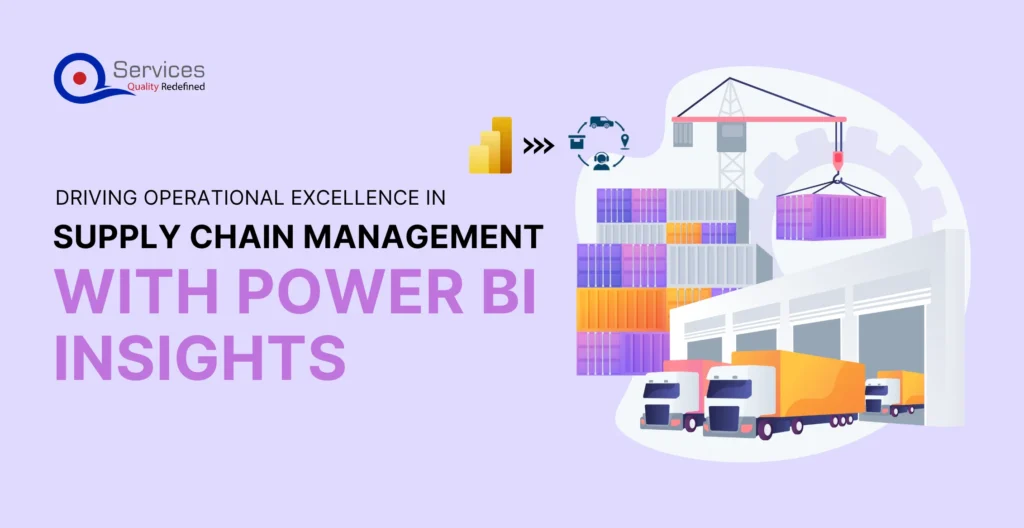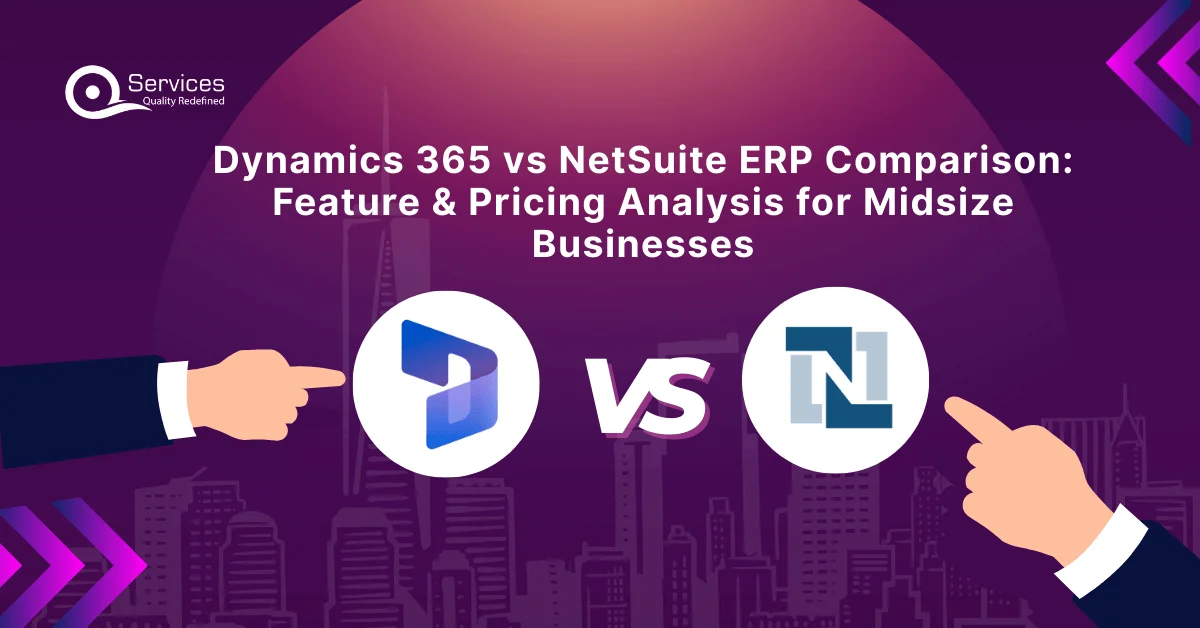
Rewards
.





CANADA
55 Village Center Place, Suite 307 Bldg 4287,
Mississauga ON L4Z 1V9, Canada
Certified Members:
.



Home » Driving Operational Excellence in Supply Chain Management with Power BI Insights

Businesses today face a relentless need to excel in supply chain management to stay ahead. How can they streamline operations, cut costs, and still deliver on time? The answer lies in utilizing data effectively. With tools like Power BI, leaders can turn data into actionable insights, navigating challenges with agility and foresight. How can visualizing supply chain data empower your decisions? Join us as in this blog we delve into operational excellence in supply chain management with Power BI insights.
Operational excellence provides organizations with a strategic edge, providing agility and responsiveness to market dynamics, which often translates into competitive advantages. This mindset not only enhances profitability and productivity through continuous process improvement but also elevates customer satisfaction in a rapidly evolving global landscape.
By using data-driven insights with the help of tools like Power BI, businesses can optimize key performance indicators such as material costs, inventory turnover, supplier lead times, and customer behavior patterns. This data-driven approach enhances supply chain efficiency and builds organizational resilience, enabling swift adaptation to disruptions like market shifts or global crises.
Furthermore, operational excellence promotes sustainability by minimizing defects, reducing waste, and improving overall supply chain outcomes.
Data Analytics plays a significant role in supply chain management (SCM) by offering valuable insights that can improve the operational efficiency of supply chain management:
Supply chain analytics optimize product quality, delivery schedules, and customer satisfaction, which boosts profitability. By analyzing data from production, distribution, and future demand, organizations streamline operations, cut costs, and improve visibility throughout the supply chain.
Data analytics help businesses predict future demand accurately by studying customer behavior and historical trends. This proactive approach assists in managing inventories effectively, preventing disruptions, and minimizing stock shortages.
Supply chain analytics identify and predict risks by spotting patterns and trends across the supply chain. This proactive identification allows businesses to address potential issues early and ensure smooth operations.
Effective data management enhances transparency by capturing and analyzing data from various stages of the supply chain. This transparency improves coordination, efficiency, and builds trust with customers and partners.
Advanced supply chain analytics, including artificial intelligence (AI), enable breakthrough innovations. AI-powered analytics analyzes large datasets to improve forecasting accuracy, identify operational inefficiencies, respond swiftly to customer needs, and foster continuous innovation.
Get free Consultation and let us know your project idea to turn into an amazing digital product.
Power BI, created by Microsoft, has transformed supply chain management by offering useful features for combining data, real-time analysis, interactive dashboards, and advanced data modeling. This self-service tool lets users create their own reports and dashboards without needing help from IT staff, making it an asset for modern supply chains.
Power BI is great at pulling together data from various sources like Excel, SQL Server, and cloud services. This flexibility gives a complete view of supply chain operations, which helps with better analysis and decision-making.
Real-time analytics are crucial in supply chain management, where timely decisions can have a big impact. Power BI allows for real-time monitoring of supply chain activities, helping businesses respond quickly to changes and emerging issues.
Power BI’s interactive dashboards offer a user-friendly method to visualize corporate data. These customizable dashboards deliver quick insights and facilitate prompt action, making them ideal for the specific needs of supply chain operations.
Power BI’s advanced data modeling capabilities convert raw supply chain data into valuable insights. This improves the effectiveness and efficiency of supply chain management by helping identify trends and patterns that inform better decision-making.
Better Decision-Making
The comprehensive and transparent perspective of supply chain activities provided by Power BI facilitates better decision-making by which businesses can make more informed decisions by merging and evaluating data from many sources. This data-driven approach may generate revenue, reduce expenses, and improve efficiency.
Improved Visibility
Having visibility is essential to supply chain management. Bottlenecks and inefficiencies can be found, and all supply chain activities can be clearly and comprehensively viewed with Power BI. To track shipment statuses in real time, for example, you can set up a dashboard that provides insightful information about distribution and logistics.
Better forecasting
Power BI’s sophisticated analytics features enable effective forecasting, crucial for inventory management and demand planning. Using an inventory dashboard by Power BI, precise forecasts can be generated from historical data. This capability enhances company planning by reducing surplus inventory and preventing stockouts, ultimately leading to higher customer satisfaction and savings on storage expenses.
Prompt Risk AssessmentThe capacity of Power BI to recognize and reduce hazards before they become significant issues is one of its main advantages. Power BI’s robust data integration capabilities and real-time analytics enable early issue discovery. Power BI, for instance, can keep an eye on supplier performance and notify companies of any potential disruptions to the supply chain.
Power BI supply chain dashboard gives you a detailed look at your supply chain operations. By keeping an eye on key numbers and performance indicators, you can spot areas that need improvement. For instance, if orders are taking too long to process, it could indicate inefficiencies that a supply chain dashboard by Power BI can identify. Regularly checking this dashboard helps maintain the smooth and efficient operation of your supply chain.
Supply Chain metrics dashboard dives deep into important supply chain numbers. By consistently tracking these numbers, you can make operations work better. For instance, if it takes too long for supplies to arrive, working more closely with suppliers can speed things up. Keeping an eye on metrics like how well your inventory is stocked improves how you manage it.
Power bi logistics dashboard focuses on making shipping and transportation better. It keeps track of how long shipments take, how much shipping costs, and how deliveries are going. It finds ways to save money and improve service. For example, finding faster ways to ship things can cut down on wait times. Negotiating better prices with shipping companies helps save money.
Power bi inventory dashboard is essential for making sure you have the right amount of stock. It keeps track of how much you have, when you run out, and when you have too much. For instance, if you often run out of things, keeping more on hand can help. Keeping an eye on extra inventory helps avoid making or ordering too much. Using these numbers makes managing inventory easier and more efficient.

To begin creating a Power BI dashboard for supply chain management, the first step is to identify the critical data sources. These sources typically include your ERP system, CRM, logistics platforms, and databases where essential supply chain data resides. These data sources are pivotal as they provide the foundation for meaningful insights and analysis.
Once the key data sources are identified, the next step involves setting up data connections within Power BI. Power BI supports a diverse array of data sources, enabling seamless integration and extraction of data. Importing data accurately and efficiently is crucial to ensure that the dashboard reflects real-time or near-real-time information from across the supply chain.
With data imported into Power BI, the focus shifts to designing the dashboard layout. This step entails selecting appropriate visual elements such as charts, graphs, maps, and tables that best illustrate the supply chain metrics and KPIs relevant to your business objectives. The layout should be intuitive and organized to facilitate easy interpretation of data by stakeholders.
Customization is key to tailoring the dashboard to specific business requirements. This involves configuring visuals to display relevant metrics, applying filters for data segmentation, and setting up drill-down capabilities for deeper insights into supply chain operations. Each customization should align closely with the strategic goals and operational challenges of the organization.
Ensuring Data Consistency and Accuracy: The reliability of a dashboard depends on how accurate and consistent its data is. It’s crucial to keep the data accurate to ensure the insights are trustworthy and useful. This involves regularly checking the data with audits and validations. Audits might include looking for duplicate entries or incorrect data types. Validations could involve comparing data with other reliable sources or using math to find any unusual numbers. These steps confirm the data is accurate, giving confidence in the insights and making sure decisions are based on the right information.
Prioritizing User-Friendly Design: dashboard needs to be easy for users to understand and use. This means making it simple to find information and nice to look at. The design should have clear paths to important details and use visuals like charts and graphs to show data clearly. Highlighting key metrics and placing them where they’re easy to see helps users understand quickly. A user-friendly design not only makes the dashboard easier to use but also gets more people involved, since they find it helpful and easy to get around.
Regular Updates and Maintenance: Dashboards should always show the newest supply chain data. This means keeping the data up-to-date and making sure the dashboard keeps working well. Regular maintenance keeps the dashboard running smoothly and quickly without any problems. This might mean fixing bugs, making it load faster, or making it easier to use. Also, updating the dashboard regularly adds new features and changes based on what users want and how the business changes. For example, if a part of the dashboard is useful, it might get better. If the business needs a change, the dashboard can change too.
To make an effective dashboard, it’s important to keep the data right, make it easy for users, and update it regularly. Following these steps helps make a dashboard that’s strong, reliable, and easy to use. This kind of dashboard gives useful insights into how supply chains work, which helps us make better decisions and run things more smoothly.
The future of BI is seeing significant advancements. Key trends include using artificial intelligence (AI) and machine learning for data analysis and integrating BI with technologies like the Internet of Things (IoT). These innovations are making BI tools easier to use and more capable.
In supply chain management, BI is becoming increasingly important. It helps companies understand operations better, find inefficiencies, and make smart decisions. Predictive analytics, powered by AI and machine learning, helps companies adjust to changing demands before they happen.
New trends include real-time analytics, easy-to-understand data visualization, and self-service BI. Real-time analytics lets businesses monitor operations and make quick decisions. User-friendly data visualization tools make complex data simpler. Self-service BI lets people create reports on their own, without needing IT help.
Microsoft’s Power BI is improving with better AI features, smoother connections with other Microsoft products, and improved data handling. These upgrades make it easier to analyze data in advanced ways and integrate with AI tools like Azure Machine Learning and Azure Cognitive Services.
Combining BI with AI, machine learning, and IoT automates data analysis and gives real-time insights across a business. This integration helps businesses predict future trends and monitor operations instantly.
IoT data helps BI by monitoring equipment in real-time, predicting when maintenance is needed, and using resources better. In retail, IoT data shows how customers act and how stores perform. When used in BI tools, this data helps make smart decisions.
BI is evolving to offer better analysis as it uses new technologies. These changes help businesses make smarter decisions faster.
Using Power BI for supply chain management is crucial for improving how businesses operate. By effectively using data, companies can make their processes more efficient and transparent. This approach also helps them be more resilient when facing disruptions. Looking ahead, advancements in business intelligence (BI) with AI, machine learning, and IoT will continue to provide real-time insights and predictive abilities across operations. As BI tools advance, they will play a bigger role in helping companies make smarter decisions quickly in the ever-changing world of supply chain management.

Our Articles are a precise collection of research and work done throughout our projects as well as our expert Foresight for the upcoming Changes in the IT Industry. We are a premier software and mobile application development firm, catering specifically to small and medium-sized businesses (SMBs). As a Microsoft Certified company, we offer a suite of services encompassing Software and Mobile Application Development, Microsoft Azure, Dynamics 365 CRM, and Microsoft PowerAutomate. Our team, comprising 90 skilled professionals, is dedicated to driving digital and app innovation, ensuring our clients receive top-tier, tailor-made solutions that align with their unique business needs.

Agentic AI is an advanced technology that can do tasks on its own, make decisions, and solve problems. Unlike basic AI, which only follows instructions, Agentic AI can figure things out, adjust when needed, and handle tricky jobs. Microsoft AI Agent is leading the way helping businesses work faster and more efficiently.

When a midsize business needs an ERP (Enterprise Resource Planning) system, two popular options are Microsoft Dynamics 365 vs NetSuite. Both are powerful, but they have different features, prices, and benefits that can impact a business. In this section, we’ll explore what each one offers and how they help growing companies.

With AI, businesses can make better decisions, improve workflows, and create new opportunities—all while saving time and resources. But how exactly does this work? Which industries use AI the most?
Power BI optimizes supply chain management by analyzing data across stages, tracking inventory, monitoring shipments, and forecasting demand. It integrates diverse data sources to offer a comprehensive view, empowering decisions through interactive dashboards and real-time reporting. Leveraging AI and machine learning, Power BI enables predictive analytics for forecasting trends and mitigating supply chain risks.
To improve Power BI dashboard performance:
1.Optimize data model: Simplify by removing unnecessary elements and use measures over calculated columns.
2. Reduce data volume: Filter and summarize data to decrease load size.
3. Use Direct Query or Live Connection: Connect directly to data sources to reduce memory use.
4. Optimize visuals: Limit visuals per page and avoid high-cardinality fields and excessive slicers.
5. Utilize Power BI Performance Analyzer: Identify and address specific performance bottlenecks in your reports.
Data analytics improves supply chain management by enhancing demand forecasting, streamlining inventory, identifying inefficiencies, mitigating risks, reducing costs, and enhancing customer satisfaction.
Supply chain optimization in BI uses data analysis to enhance supply chain efficiency by identifying and addressing bottlenecks, optimizing inventory, improving delivery times, reducing costs, and boosting customer satisfaction through data-driven decisions and visual insights.
Events in Progress: This technique helps track open inventory on any day, providing insights over time.
Data Modeling: Creating a robust data model in Power BI ensures accurate analysis and visualization of supply chain data.
Data-driven decision making is crucial. Analytical teams can identify hidden risks and opportunities in unstructured data, leading to better supply chain outcomes
.





55 Village Center Place, Suite 307 Bldg 4287,
Mississauga ON L4Z 1V9, Canada
.




Founder and CEO

Chief Sales Officer

🎉 Thank you for your feedback! We appreciate it. 🙌